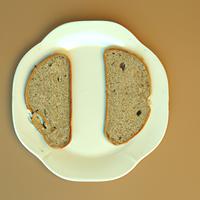
1 serving (64 grams) contains 160 calories, 4.0 grams of protein, 3.0 grams of fat, and 30.0 grams of carbohydrates.

Log this food in SnapCalorie

Nutrition Information
Calories |
592.6 | ||
|---|---|---|---|
% Daily Value* |
|||
| Total Fat | 11.1 g | 14% | |
| Saturated Fat | 1.9 g | 9% | |
| Polyunsaturated Fat | 0 g | ||
| Cholesterol | 0 mg | 0% | |
| Sodium | 1111.1 mg | 48% | |
| Total Carbohydrates | 111.1 g | 40% | |
| Dietary Fiber | 7.4 g | 26% | |
| Sugars | 7.4 g | ||
| protein | 14.8 g | 29% | |
| Vitamin D | 0 mcg | 0% | |
| Calcium | 148.1 mg | 11% | |
| Iron | 4.4 mg | 24% | |
| Potassium | 185.2 mg | 3% | |
* Percent Daily Values are based on a 2,000 calorie diet. Your daily values may be higher or lower depending on your calorie needs.
Food Attributes
Source of Calories
About Two slices of gluten-free bread
Two slices of gluten-free bread are a versatile staple made from alternative flours like rice, almond, or tapioca, ensuring suitability for those with gluten intolerances or celiac disease. Typically light and slightly dense in texture, this bread often incorporates ingredients like eggs, oils, and natural binders such as xanthan gum to replicate the elasticity of traditional wheat bread. Popular in Western cuisines, especially in health-conscious or specialized dietary spaces, gluten-free bread serves as a base for sandwiches, toast, or other recipes. Nutritionally, it can be lower in fiber and protein compared to whole-grain wheat breads, depending on the recipe, but often contains essential vitamins and minerals. Many versions are free from artificial additives, providing a cleaner option for sensitive diets. While gluten-free bread can be healthier for individuals with specific dietary needs, consumers should check labels for added sugars or lower nutrient counts in certain brands.



